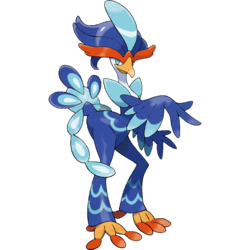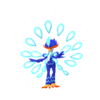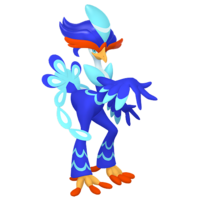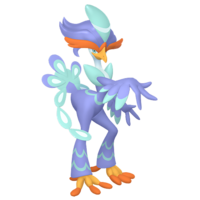From Bulbapedia, the community-driven Pokémon encyclopedia.
|
Tags: Mobile edit Mobile web edit |
| Line 280: |
Line 280: |
|
| |
|
| ===Origin=== | | ===Origin=== |
| Quaquaval may be primarily based on a {{wp|Crested (duck breed)|crested duck}} or {{wp|Roman goose}}. Its lobed feet and red head ornamentation suggest it could also take inspiration from the {{wp|red-knobbed coot}}. The water feathers around its tail are visually and functionally based on the {{wp|covert feather|train}} of a {{wp|peacock}}. The association between ducks or geese and peacocks could date to ancient Rome, where both the crested goose and the peacock were sacred animals of the goddess {{wp|Juno (mythology)|Juno}}. | | Quaquaval may be primarily based on a {{wp|peacock}}, as its coloration and water feathers around its tail, which are visually and functionally based on the {{wp|covert feather|train}} of said bird, suggest, as well as on the Iberian {{wp|red-knobbed coot}}, with whom it shares the lobed feet and the red head ornamentation. The {{wp|Crested (duck breed)|crested duck}} or {{wp|Roman goose}} could also take part of its inspiration. The association between ducks or geese and peacocks could date to ancient Rome, where both the crested goose and the peacock were sacred animals of the goddess {{wp|Juno (mythology)|Juno}}. |
|
| |
|
| Quaquaval may also took inspiration on carnivalesque performers, such as those from the {{wp|Carnival of Santa Cruz de Tenerife}} in the Canary Islands. Considering its dancelike movements and exuberant plumage, Quaquaval particularly resembles the {{wp|pt:Escola de samba#A corte da bateria|rainha de bateria}} dancer allegory from the {{wp|Rio Carnival}} of {{wp|Brazil}}; this is notable with the mentions to far-away lands in Quaquaval's Pokédex entries. The carnival dance it performs could be inspired by {{wp|Samba (Brazilian dance)|samba}}, an Afro-Brazilian dance that became part of the national identity of Brazil. Its Fighting type and [[signature move]], {{m|Aqua Step}}, may be based on {{wp|capoeira}}, a martial art that combines elements of dance which also originated in Brazil. | | Quaquaval may also took inspiration on carnivalesque performers, such as those from the {{wp|Carnival of Santa Cruz de Tenerife}} in the Canary Islands, which are known for their distance from the Iberian Peninsula despite being part of Spain; thing referenced in Quaquaval's Pokédex entries with the mentions to far-away lands. Considering its dancelike movements and exuberant plumage, Quaquaval particularly resembles the {{wp|pt:Escola de samba#A corte da bateria|rainha de bateria}} dancer allegory from the {{wp|Rio Carnival}} of {{wp|Brazil}}. The carnival dance it performs could be inspired by {{wp|Samba (Brazilian dance)|samba}}, an Afro-Brazilian dance that became part of the national identity of Brazil. Its Fighting type and [[signature move]], {{m|Aqua Step}}, may be based on {{wp|capoeira}}, a martial art that combines elements of dance which also originated in Brazil. |
|
| |
|
| Quaquaval could also be inspired by the {{wp|Basque mythology|Basque}} {{wp|Lamia (Basque mythology)|Lamia}}, a duck-footed woman-like cryptid known for living around rivers, where they would often comb their hair. | | Quaquaval could also be inspired by the {{wp|Basque mythology|Basque}} {{wp|Lamia (Basque mythology)|Lamia}}, a duck-footed woman-like cryptid known for living around rivers, where they would often comb their hair. |
Revision as of 03:19, 8 December 2023
Quaquaval (Japanese: ウェーニバル Wanival) is a dual-type Water/Fighting Pokémon introduced in Generation IX.
It evolves from Quaxwell starting at level 36. It is the final form of Quaxly.
Biology

Quaquaval's water feathers
Quaquaval is a humanoid Pokémon resembling a waterfowl. Its plumage is mostly dark blue, except for the light blue on its shoulders and tail, along with the white on its head, neck, chest, and individual tail feathers. Its face has blue eyes and a pointed yellow beak. Atop its head is a large, flowing, slick, dark blue crest, with long light blue and orange-red feathers at the front, separating the crest from the head. Its forearms have three sets of feathers, each tipped with light blue; and it has what resembles hands with three "fingers" each. Additional light blue accents decorate its waist and legs. Its yellow feet have bulbous segments with three toes each; the front-most segments are orange in color. It has a defined rump and an elaborate-looking tail, with a circular base and three teardrop-shaped feathers decorating it at the top, along with two chains consisting of three feathers flanking it on either side.
In battle, Quaquaval is accompanied with a series of teardrop-shaped decorative water feathers, which are ejected from the organs on its tail feathers and fanned out behind its back. When attacking, these water feathers move forward and spin around Quaquaval's body, making a buzzsaw-like arrangement that it uses to slice into its enemies. Quaquaval's legs are well-trained and have incredible strength, being able to launch a truck away with a single kick. It uses its legs to perform dance moves, some of which appear to be based on dances from faraway lands.[1] Quaquaval is viewed by Tsareena as its rival.
Quaquaval has a cheerful and energetic disposition, dancing away no matter what situation it faces. However, it is also stoic and very serious, especially when it comes to consistently polishing its skills. It can become very focused during critical situations.[1]
Quaquaval is the only known Pokémon capable of learning the move Aqua Step.
Evolution
Quaquaval evolves from Quaxwell and is the final form of Quaxly.
(For specifics on this Pokémon's evolution in the games, refer to Game data→Evolution data.)
In the anime
Major appearances
Minor appearances
In the manga
In the TCG
- Main article: Quaquaval (TCG)
Game data
Pokédex entries
| This Pokémon was unavailable prior to Generation IX.
|
| Generation IX
|
|
Paldea
#9
|
|
Kitakami
#—
|
| Scarlet
|
A single kick from a Quaquaval can send a truck rolling. This Pokémon uses its powerful legs to perform striking dances from far-off lands.
|
| Violet
|
Dancing in ways that evoke far-away places, this Pokémon mesmerizes all that see it. Flourishes of its decorative water feathers slice into its foes.
|
|
|
Game locations
| This Pokémon was unavailable prior to Generation IX.
|
|
|
Stats
Base stats
| Stat
|
Range
|
| At Lv. 50
|
At Lv. 100
|
85
|
|
145 - 192
|
280 - 374
|
120
|
|
112 - 189
|
220 - 372
|
80
|
|
76 - 145
|
148 - 284
|
85
|
|
81 - 150
|
157 - 295
|
75
|
|
72 - 139
|
139 - 273
|
85
|
|
81 - 150
|
157 - 295
|
Total: 530
|
Other Pokémon with this total
|
- Minimum stats are calculated with 0 EVs, IVs of 0, and (if applicable) a hindering nature.
- Maximum stats are calculated with 252 EVs, IVs of 31, and (if applicable) a helpful nature.
|
Type effectiveness
| Under normal battle conditions in Generation IX, this Pokémon is:
|
|
|
|
|
|
|
|
|
|
|
|
|
Learnset
|
|
|
|
- Bold indicates a move that gets STAB when used by Quaquaval
- Italic indicates a move that gets STAB only when used by an Evolution of Quaquaval
|
|
|
|
|
- Bold indicates a move that gets STAB when used by Quaquaval
- Italic indicates a move that gets STAB only when used by an Evolution or an alternate form of Quaquaval
|
|
|
|
|
- Moves marked with an asterisk (*) must be chain bred onto Quaquaval
- Bold indicates a move that gets STAB when used by Quaquaval
- Italic indicates a move that gets STAB only when used by an Evolution of Quaquaval
|
|
|
|
|
- Bold indicates a move that gets STAB when used by Quaquaval
- Italic indicates a move that gets STAB only when used by an Evolution of Quaquaval
|
Side game data
Evolution data
Sprites
| This Pokémon was unavailable prior to Generation IX.
|
|
|
|
|
Trivia
Origin
Quaquaval may be primarily based on a peacock, as its coloration and water feathers around its tail, which are visually and functionally based on the train of said bird, suggest, as well as on the Iberian red-knobbed coot, with whom it shares the lobed feet and the red head ornamentation. The crested duck or Roman goose could also take part of its inspiration. The association between ducks or geese and peacocks could date to ancient Rome, where both the crested goose and the peacock were sacred animals of the goddess Juno.
Quaquaval may also took inspiration on carnivalesque performers, such as those from the Carnival of Santa Cruz de Tenerife in the Canary Islands, which are known for their distance from the Iberian Peninsula despite being part of Spain; thing referenced in Quaquaval's Pokédex entries with the mentions to far-away lands. Considering its dancelike movements and exuberant plumage, Quaquaval particularly resembles the rainha de bateria dancer allegory from the Rio Carnival of Brazil. The carnival dance it performs could be inspired by samba, an Afro-Brazilian dance that became part of the national identity of Brazil. Its Fighting type and signature move, Aqua Step, may be based on capoeira, a martial art that combines elements of dance which also originated in Brazil.
Quaquaval could also be inspired by the Basque Lamia, a duck-footed woman-like cryptid known for living around rivers, where they would often comb their hair.
Name origin
Quaquaval may be a combination of quá-quá (Portuguese onomatopoeia for duck sounds), aqua, and carnaval (Spanish and Portuguese for carnival). The name also appears to draw from the adjective quaquaversal, referring to a pattern that radiates in all directions from a common center; such is the case for the water feathers that fan out from Quaquaval's tail during battle.
Wanival may be a combination of wave and carnival.
In other languages
| Language
|
Title
|
Meaning
|
 Japanese Japanese
|
ウェーニバル Wanival
|
From wave and carnival
|
 French French
|
Palmaval
|
From palmipède and carnaval
|
 Spanish Spanish
|
Quaquaval
|
Same as English name
|
 German German
|
Bailonda
|
From baile and onda
|
 Italian Italian
|
Quaquaval
|
Same as English name
|
 Korean Korean
|
웨이니발 Weinibal
|
From wave and carnival
|
 Mandarin Chinese Mandarin Chinese
|
狂歡浪舞鴨 / 狂欢浪舞鸭 Kuánghuānlàngwǔyā
|
From 狂歡 / 狂欢 kuánghuān, 浪 làng, 舞 wǔ, and 鴨 / 鸭 yā
|
 Cantonese Chinese Cantonese Chinese
|
狂歡浪舞鴨 Kòhngfūnlohngmóuh'aap
|
From 狂歡 kòhngfūn, 浪 lohng, 舞 móuh, and 鴨 aap
|
|
|
|
| More languages
|
 Hindi Hindi
|
वेवार्निवल Vevārnival
|
From wave and carnival
|
 Thai Thai
|
เวนิวัล Weniwan
|
Transcription of Japanese name
|
|
|
|
Related articles
References
External links

|
This Pokémon article is part of Project Pokédex, a Bulbapedia project that aims to write comprehensive articles on each Pokémon species, as well as Pokémon groups and forms.
|
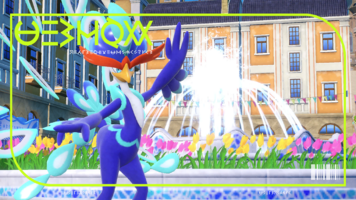
 For other sprites and images, please see Quaquaval images on the Bulbagarden Archives.
For other sprites and images, please see Quaquaval images on the Bulbagarden Archives.
